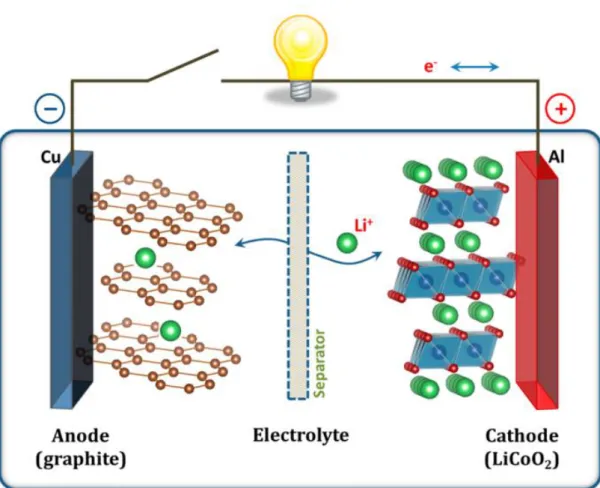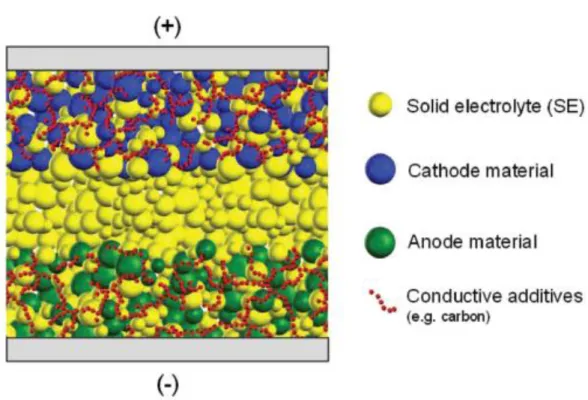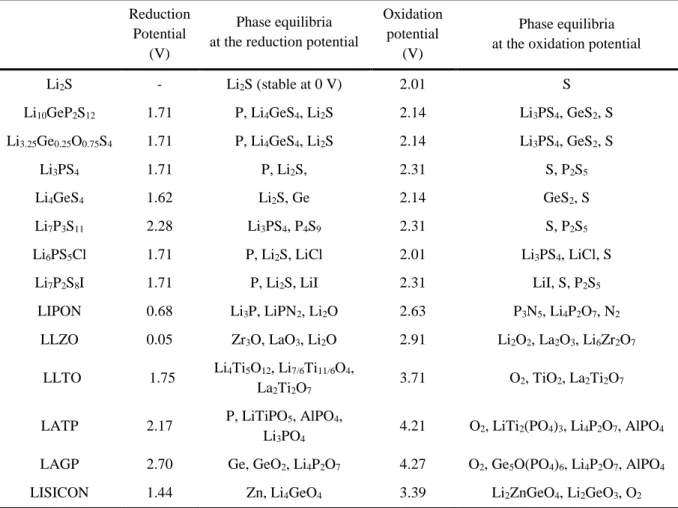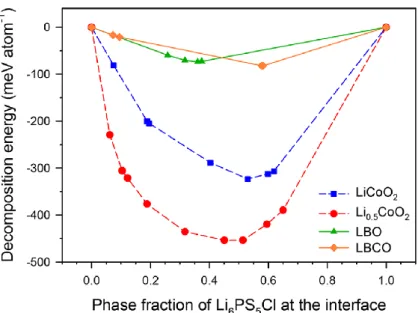Calculated mutual decomposition energy of Li6PS5Cl with pristine and delithiated LiCoO2, LBO (Li3BO3) and LBCO (Li3−xB1−xCxO3, x = 0.80) at different phase fractions of Li6PS5Cl in the mixed compounds. Characterization of c-bar (cleaned bar), LBO-coated (0.5 wt%) and LBCO-coated (0.5 wt% of LBO) LiCoO2 by electron microscopy analysis. FESEM (upper) and the corresponding BSE (lower) images for (a) c-bare, (b) LBO-coated and (c) LBCO-coated LiCoO2 particles.
Results for c-bare, bare and a-LBCO coated (artificial-LBCO coated) LiCoO2 are compared in (a,b). The results for c-bare, bare and a-LBCO-coated (artificial-LBCO-coated) LiCoO2 are compared in (a-b). Cycling performance for LiCoO2/Li−In semiconductor cells using c-bare, LBO-coated, and LBCO-coated LiCoO2 at 0.2 C and 30 °C.
XPS results of Co 2p signal for c-bare, LBO-coated (0.1 wt%) and LBCO-coated (0.5 wt% of LBO) LiCoO2 for pristine powders and electrodes after cycling. Schematic diagram illustrating the different interface characteristics of bare and LBCO-coated LiCoO2 in all-solid cell electrodes.
Introduction
LiNbO3 is one of the most commonly used coating materials for sulfide ASLBs due to its high Li+ conductivity of ~10−6 S cm−1 at room temperature and a simple preparation protocol based on the wet method using alcohols (Table However, Nb is not soil). -abundant and the use of flammable alcohol in the coating process would be of concern in scaling up. Although these findings on the correlation between Li+ conductivity of coating materials and electrochemical performance are helpful in the design of alternative coating materials, it should be noted that several aspects of not only Li+ conductivity, but also scalable preparation and cost-effectiveness need to be carefully considered. In addition, a detailed understanding of the evolution at the electrode-SE interfaces affected by the protective coatings is required.
Despite its relatively low Li+ conductivity S cm−1 at 30 °C, measured in this work), LBO has been investigated as a sintering aid for oxide SE materials, such as Li7La3Zr2O12, for oxide-based ASLBs, as it can help around the sintering temperatures for the oxide SEs due to its low melting point (700 °C).45-50 However, until now there has been no report on the application of LBO or LBO-derived materials for sulfide-based ASLBs. LBO-LCO or Li3-xB1-xCxO3 (LBCO)) protective coatings prepared by a simple and scalable wet protocol using water, which drastically improve the electrochemical performances of LiCoO2 for ASLBs using sulfide SEs. Complementary analyzes show that the ash-derived highly conductive, thick and high surface area LBCO coatings for LiCoO2 effectively suppress the formation of detrimental Co3S4 phase and form good passivating layers consisting of phosphates, thereby minimizing interfacial resistances.
Compared to other coating materials, LBCO and its precursor are cost-effective and environmentally friendly (Table 1). Additionally, the use of water as a solvent is a significant advantage that avoids the use of flammable solvents used in typical coating procedures.
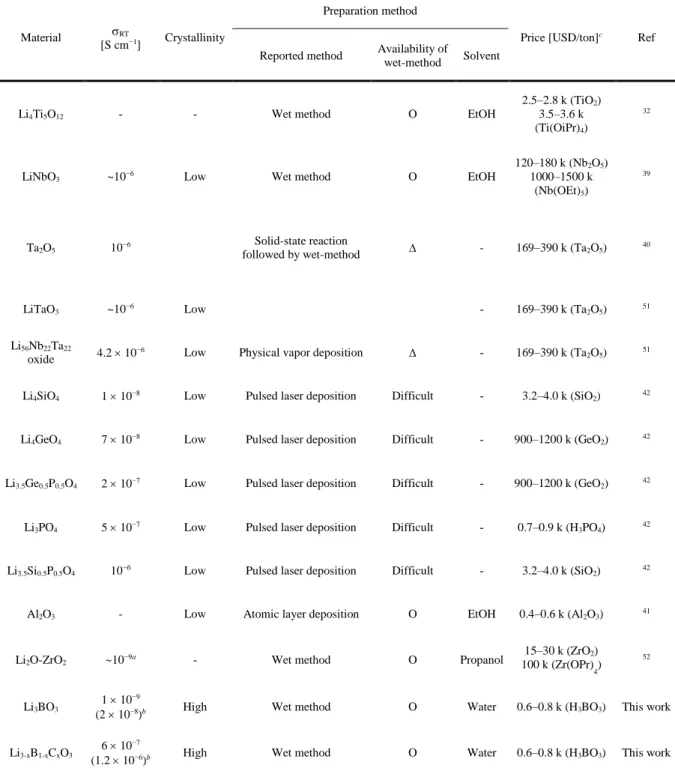
Background
Principle of lithium-ion secondary batteries
All-solid-state lithium-ion batteries
- Solid electrolytes
- Bulk-type all-solid-state lithium-ion batteries
- Interfacial issues for bulk-type all-solid-state lithium-ion batteries
58-60 Recently, ASLBs have attracted attention not only as portable electronic devices but also as large-scale batteries.61, 62 As shown in Figure 3, an important feature of bulk-type ASLB is its composite. Thick composite electrodes of ASLBs indicate that increased energy density can compete with conventional LIBs, but this requires high ionic conductivity of SEs comparable to that of LEs. The oxide-based and sulfide-based SEs have been extensively investigated as suitable SEs for bulk-type ASLBs.
Radar plots of the performance properties of solid oxide electrolytes (panel a), solid sulfide electrolytes (panel b), solid hydride electrolytes (panel c), solid halide electrolytes (panel d), thin film electrolytes ( panel e) and solid polymer electrolytes (panel f). As a result of testing with this method, a very wide electrochemical window from 0V to 5V was reported in most sulfide and oxide SEs.20, 63 However, the electrochemical performance of bulk-type ASLBs assembled with these SE is much worse than conventional based LIBs. in LE, although SEs have high ionic conductivity comparable to liquid electrolytes.20, 31 Recent thermodynamic calculations show that SEs have very narrow electrochemical windows, unlike conventional experimental results (Table 2). 25, 27. High interfacial resistance is often insisted as a major limiting factor in the performance of ASLBs.64 Although not yet fully understood, the origin of interfacial resistance is often due to physical interfacial contact,12 the formation of layers of space charge65 and/or the formation of mutual interfacial layers due to chemical/electrochemical reactions between electrolytes and electrodes. Although various interface processing techniques such as dynamic printing, 12 nanosizing,66 co-sintering67 and surface coating12, 32, 39 have tried to create interfaces between electrode materials and SEs, the performance of ASLBs is still considerable. lower than that of a conventional LIB.
Understanding and solving the interface problems between electrode materials and SEs will be the key to surpass the performance of the conventional LIBs. Electrochemical window and phase equilibria at the reduction and oxidation potentials of the solid electrolyte materials.
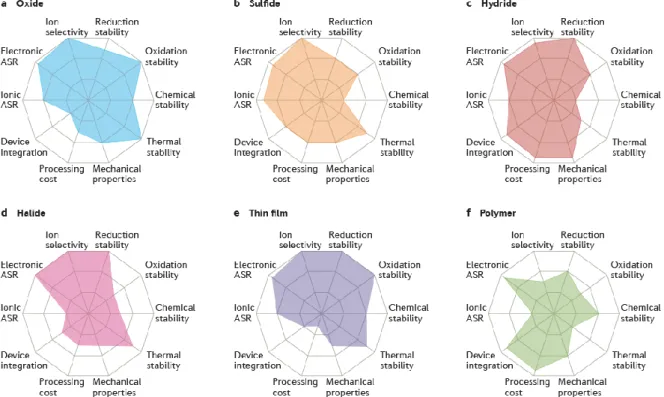
Experimental
- Preparation of materials
- Thermodynamic calculations
- Materials characterization
- Electrochemical characterizations
The XPS data were collected with a monochromatic Al K source (1486.6 eV) at 72 W, 12 kV and 6 mA using an X-ray photoelectron spectrometer (ThermoFisher). For the ex-situ XPS measurements, the collected samples were placed in an Ar-filled dry glove box and loaded into the XPS equipment for a short time while minimizing exposure to air. The weight fraction of the coating materials was determined using inductively coupled plasma optical emission spectroscopy (ICP-OES, 720-ES, Varian).
To measure Li+ conductivity, LBO and LBCO pellets were prepared by cold pressing the powders at 370 MPa and subsequent sintering at 600 °C for 10 hours in air. The thus prepared pellets were subjected to measurements of Li+ conductivity by the AC impedance method (Iviumstat, IVIUM Technologies Corp.) using symmetrical Al (c-Al)/pellet/c-Al lithium-ion blocking cells. LiCoO2/Li-In semiconductor cells were prepared as follows. 12, 23 Partially lithiated indium (Li0.5In, nominal composition) powders were prepared by mechanically grinding a mixture of In (Sigma Aldrich, 99.99%) and Li (FMC Lithium Corp.).
Results and Discussion
Thermodynamic calculations of coating materials
Characterization of coating materials and coated active materials
The strong peaks found at 1230 eV for bare and c-bare samples correspond to ions backscattered by Co into LiCoO2. The lower intensity of the Co peak obtained for the bare sample compared to that obtained for the c-bare sample is due to surface impurities containing Li2CO3. In addition, the LBO and LBCO coated samples showed a much more weakened Co peak, indicating that the Co atoms are well covered by the coating layers.
Assuming that the surfaces of the c-bare sample were perfectly exposed, the surface coverages of the other samples were determined by comparing the intensities of the Co peaks, and are shown in Table 6. For the bare sample, 21% of the surface is covered by impurities, such as Li2CO3. The surface coverages for LBO and LBCO coated samples appear to be 79% and 87%, respectively.
The higher surface coverage found for the LBCO-coated sample than the LBO-coated one is attributed to the larger overall amount of coating materials.
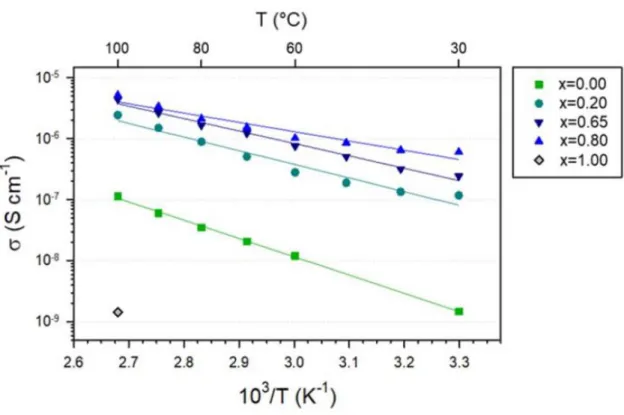
Electrochemical characterizations
Electrochemical characterization of LiCoO2/Li−In all-solid-state cells at 30 °C. a) Transient discharge voltage profiles obtained by GITT. The corresponding equivalent circuit model and interface resistances are shown in Figure 15 and Table 7, respectively.
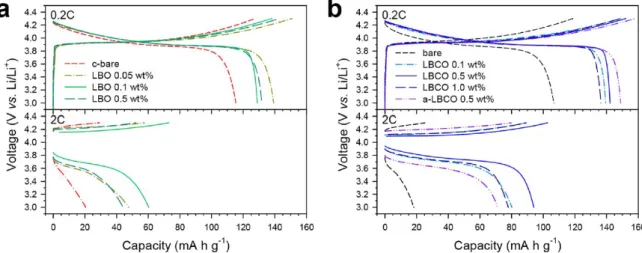
Ex-situ surface analysis
Conclusion
Design strategies, practical considerations and new solution processes for solid sulfide electrolytes for all-solid batteries. Towards Practical All-Solid-State Lithium-Ion Batteries with High Energy Density and Safety: Comparative Study for Electrodes Made by Dry and Slurry Mixing Processes. First principle study of electrochemical and chemical stability of solid electrolyte-electrode interfaces in all-solid-state Li-ion batteries.
Bendable and thin sulfide solid electrolyte film: a new electrolyte opportunity for free-standing and stackable high-energy, all-solid lithium-ion batteries. Interfacial observation between LiCoO2 electrode and Li2S-P2S5 solid electrolytes of solid-state secondary lithium batteries using transmission electron microscopy. Enhancing the high capacity of solid-state lithium batteries through nanoscale interface modification.
Infiltration of solution-processable solid electrolytes into conventional Li-Ion battery electrodes for solid-state Li-Ion batteries. Solid-state lithium-ion battery using garnet-type oxide and Li3BO3 solid electrolyte produced by screen printing. Co-sinterable lithium-garnet oxide electrolyte with cathode for solid-state lithium-ion batteries.
Electrochemical Characterization of the Cathode Interface of a Solid-State Lithium-Ion Battery: LiCoO2 and Garnet-Li7La3Zr2O12 Interface. A high-throughput approach to the development of lithium-niobium-tantaloxides as electrolyte/cathode interlayers for high-voltage solid-state lithium batteries. Space-Charge Layer Effect at interface between oxide cathode and sulfide electrolyte in All-Solid-State Lithium-Ion battery.
Enhanced performance of all-solid-state lithium-ion batteries using active nanosilicon material with multi-walled carbon nanotubes as a conductive additive. Redox activity of argyrodite Li6PS5Cl electrolyte in a completely solid Li-ion battery: an XPS study. Li3BO3-Li2CO3: Rationally designed buffer stage for sulfide All-Solid-State Li-Ion batteries.
